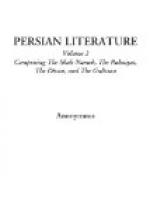Sa’di had begun his life as a student of the Koran and became early imbued with the quietism of Islam. The cheerfulness and exuberant joy which characterize the poems he wrote before he reached his fortieth year, had bubbled up under the repressions of severe discipline and austerity. But the religion of Mohammed was soon exchanged by him, under the guidance of a famous teacher, for the wider and more transcendental system of Sufism. Within the area of this magnificent scheme, the boldest ever formulated under the name of religion, he found the liberty which his soul desired. Early discipline had made him a morally sound man, and it is the goodness of Sa’di that lends such a warm and endearing charm to his works. The last finish was given to his intellectual training by the travels which he took after the Tartar invasion desolated Persia, in the thirteenth century. India, Arabia, Syria, were in turn visited. He found Damascus a congenial halting-place, and lived there for some time, with an increasing reputation as a sage and poet. He preached at Baalbec on the fugitiveness of human life, on faith, love, and rest in God. He wandered, like Jerome, in the wilderness about Jerusalem, and worked as a slave in Africa in the trenches of Tripoli: he travelled the length and breadth of Asia Minor. When he arrived back at Shiraz, he had passed the limit of three-score years and ten, and there he remained in his hermitage and his garden, to arrange the result of all his studies, his experiences, and his sufferings, in that consummate work which he has named the “Rose Garden,” after the little cultivated plot in which he spent his declining days and drew his last breath.
The “Gulistan” is divided into eight chapters, each dealing with a specific subject and partaking of the nature of an essay: although these chapters are composed of disjointed paragraphs, generally beginning with an aphorism or an anecdote and closing with an original poem of a few lines. Sometimes these paragraphs are altogether lyrical. We are struck, first of all, by the personal character of these paragraphs; many of them relate the experience of the poet in some part of his travels, expressing his comment upon what he had seen and heard. His comments generally take the form of practical wisdom, or religious suggestion. He gives us the impression that he knows life and the human heart thoroughly. It may be said of him, as Arnold said of Sophocles, he was one “who saw life steadily, and saw it whole.” On the other hand, there is not the slightest trace of cynical acerbity in his writings. He has passed through the world in the independence of a self-possessed soul, and has found it all good, saving for the folly of fools and the wretchedness and degradation of the depraved. There is no bitter fountain in the “Rose Garden,” and the old man’s heart is as fresh as when he left Shiraz, thirty years before; the sprightliness of his poetry has only been ripened and tempered to a more exquisite flavor, by the increase of wisdom and the perfecting of art.




